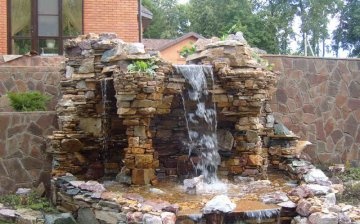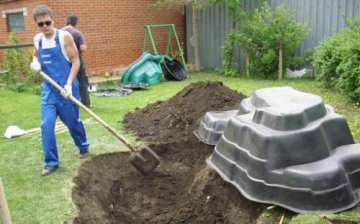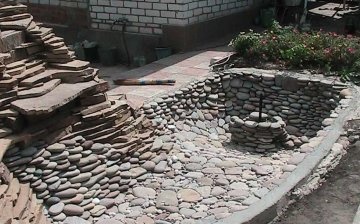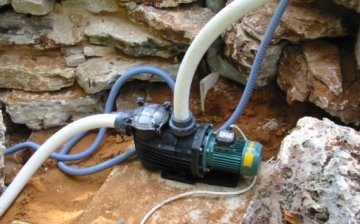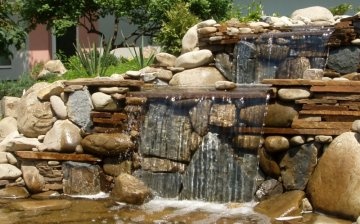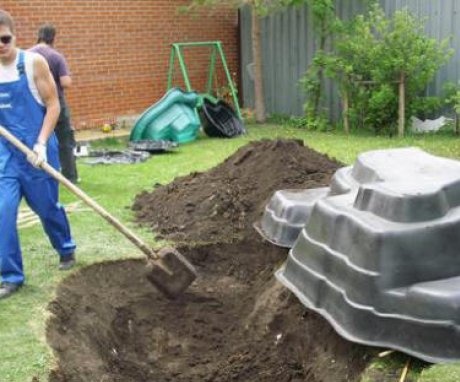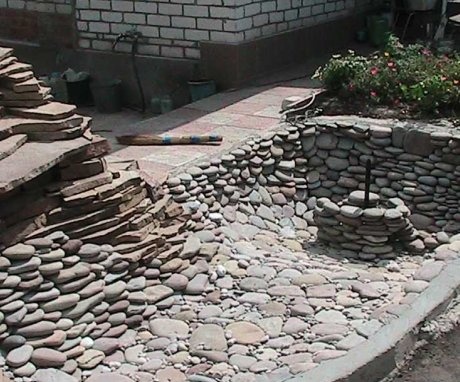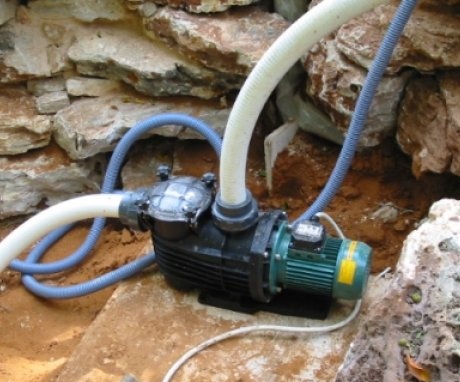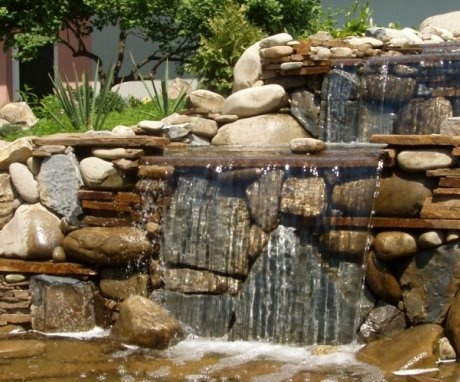How to build and decorate an artificial waterfall with your own hands
Each owner of a country house wants to make the site as comfortable as possible, where you can take a break from the bustle of the city. In a small area, you can arrange a whole lake with waterfalls, rocky slopes and other wonders of nature.
Content:
- Initial stage: preparation for construction
- Start of construction: formation of the thicket
- The main stage of construction: formation of the bed and installation of the pump
- Garden waterfall decoration
Initial stage: preparation for construction
Before you start making an artificial waterfall with your own hands, you need to carefully study its location. On site, you need to determine the composition of the soil, the location of groundwater.
A waterfall of any size consists of two parts: a cascade and a tank.
The water flows through the cascade into a container, in which it is located for a certain amount of time. Since the water must come from somewhere, it circulates in a circle. For this, a pump is installed.
It will be much easier to install a waterfall if the site already has a pond or pool. Only one cascade and a pump for water circulation can be installed in them. If the waterfall is being built from scratch, you will have to spend more time and effort.
Tricks in building an artificial waterfall:
- First you need to decide what shape and size the waterfall will be. The height of the cascade is calculated, the volume of the tank, which will be filled with water.
- The shape of the bowl is chosen based on personal preferences and the general appearance of the site. This has no fundamental difference and does not affect functionality.
- Designers love to use curved bowls that look most like natural formations. Containers look good, which are visually a continuation of the relief of the site, and do not stand out from it.
- You can purchase equipment after the depth of the structure has been determined. A waterfall can have more than just a decorative function.
- The containers can be planted with aquatic plants, algae and exotic fish. In the latter case, the depth should be more than 1 meter, in order to avoid water freezing.
The artificial waterfall has a beneficial effect on the life of fish and plants. The water is constantly being enriched with oxygen. Also, any living creature feels better in moving water. In such a container there is no risk of a sharp change in water temperature, which is especially important in summer and winter.
Regular shapes, right angles, regular circles and ovals are rarely found in nature.
This must be taken into account when choosing a waterfall design. Waterfalls of a regular rectangular shape are often used on a site that is decorated in high-tech style or any other modern look. To make the right choice, you can look at catalogs with finished works.
Start of construction: formation of the thicket
Having picked up a sketch of the future waterfall, you can start laying it in the ground. According to all measurements, you need to dig a pit. It is imperative to take into account the additional centimeters that will take away the frame and arrangement of the substrate.
The place for the bowl should be as flat as possible. In the selected area, you need to remove all unnecessary things, remove the hills with a shovel.
The base must be strong, so the soil must be tamped. To make the bottom durable, an additional layer of sand and crushed stone is laid and also tamped well. To consolidate the result, you need to add water when tamping.
The most important parts of a waterfall for its long-term use are a strong bowl and high-quality waterproofing.
Well-done waterproofing is necessary so that the base is not eroded by the constant flow of water. Also, water can gradually destroy the integrity of the banks, so they must be well fortified.
For waterproofing, PVC film is most often used. Its minimum service life is 15-20 years, good material will last much longer than the specified period.
You can make a waterproof coating from:
- PVC films
- EPDM films
- Butyl Rubber Film
- Concreting
There are other materials for arranging waterproofing, but PVC film has more advantages than disadvantages. The film will not work if fish will be raised in the waterfall all year round. In winter, the film can freeze and burst, so the water will need to be drained during the cold season.
EPDM is a synthetic rubber. This rubber film has a high level of elasticity and is easy to work with. The properties of the film are associated with a unique porous structure. This material belongs to the premium class, so its cost is quite high.
Butyl rubber film:
- Designed specifically to cover pools and artificial lakes, waterfalls.
- It is resistant to severe frost and heat.
- Butyl rubber film stretches well, so it can be used on uneven surfaces.
- It is also practically durable. The producers promise that the film will last over 50 years.
- Having chosen such a coating, you will have to spend money not only on the material itself, but also on components.
- When installing the film, you need to fix it well, so you need to cut it off 50 cm more on each side.
The structure can be reinforced with concrete. A concrete bowl is much stronger and more durable, but it is difficult to design it without construction skills. The water in the concrete bowl can be kept all year round.
The concrete is not poured immediately onto the bare ground. First, the base is covered with a thick plastic wrap, after which a metal frame is constructed, and only then can concrete be poured.
When the concrete bottom dries up, you can cover the walls.
Also, the formwork is installed first, and then the pouring is performed. To cover the walls with reinforcement, they do not resort to welding, but only tie the parts with wire.
The main stage of construction: formation of the bed and installation of the pump
When the bowl is formed and the base is laid, the formation of the cascade can begin. In construction hypermarkets or specialized stores, you can purchase a ready-made form. You can find a foundation that will continue decorate at your own discretion.
You need to clearly imagine how the waterfall will look in order to direct the main stream of water, where to make additional streams, where they will flow into the waterfall, etc.
To make a cascade on your own, according to your own sketch, work begins with the installation of ledges. Their height should not be more than 30 cm. It is logical that the work starts from the bottom and gradually, ledge by ledge, rises up.
To make the waterfall closer to its natural appearance, it is made from natural stones:
- They are more durable than artificial ones.
- Natural stones exist in various price categories.
- Sandstone has high decorative properties. The democratic price makes it popular.
- So that the stones hold well, they are fixed on a cement mortar. In addition to the ledges, you need to take care of the sides in the place where the entire stream of water will be directed. This is to prevent splashing water.
The pump allows water to circulate and rise from the bowl to the top, from where it will freely descend over the stones. The higher and larger the waterfall, the more powerful the pump is needed. When choosing a pump, you need to pay attention to the presence of a function for regulating water flows. Thus, you can make the waterfall more powerful or weaker, depending on your mood.
The sediment itself is installed at the very bottom of the water tank so that it cannot be seen.
The pump should have two windows, the first is where the water will be sucked. The hose that extends from the first window is directed upward. The second window is needed to push out the water, it will remain at the bottom of the bowl.
The transformer to which the pump will be connected must be in the room. It must also be low voltage. If there are not enough cables for the full length, they can be connected together. The connectors are selected to be waterproof and installed to prevent water seepage. The pump characteristic is determined in liters per hour. When choosing a sediment, you need to carefully select this parameter, depending on the volume of the reservoir.
Garden waterfall decoration
After completing all the technical work, you can start decorating the waterfall. Only then will it have a complete look.
The easiest to deal with is classic style or vintage style. In the second case, any items that are lying around in the attic or in the garage will do. You can use old pipes, clay pots, any broken dishes, and other ceramic products.
Decorating begins only after checking the performance of the drift and the overall functionality of the waterfall.
There are no specific rules or restrictions when decorating.
You can make the most of your imagination and embody the most daring ideas:
- From the site where the waterfall is located, you can make a real personal protected area.
- Alpine slides and various sculptures will help to decorate it.
- Fish can swim in the water and grow flowers.
- In a humid environment, they are planted iris, valerian, fern, buzulnik, calamus.
- Waterfalls and artificial ponds are often decorated with LED lights. It will be pleasant to rest near such beauty in the dark, as well as when organizing parties.
- It is impossible not to mention such materials as gravel and pebbles. They are laid out along the banks.
- Next to the waterfall, you can install a gazebo or just put benches, hang a hammock or make any other device for relaxation.
- If you have children at home or just like this style, you can install figures of heroes from your favorite fairy tales.
- Recently, more and more designers are opting for floating lanterns. They are moved by the flow of water that the pump creates. At night it looks original and fabulous.
A place near the waterfall in the garden will give you the opportunity to have a good time, relax, gain vitality for new achievements.
More information can be found in the video.



